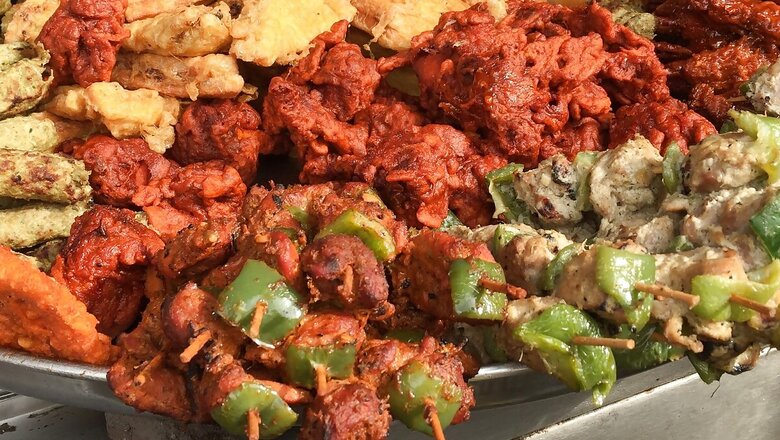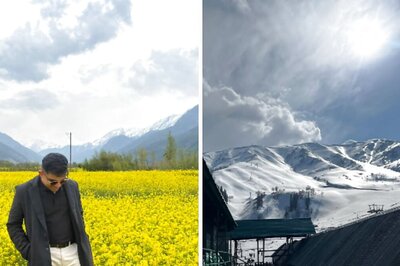
views
This time, the bazaars and cloisters were a bit quieter, more subdued than I have ever remembered. The food shops outside Minara Masjid were open but lacked the vigour and vitality of a usual Ramzan month. Even the bright colours of the sweets at Suleman Usman Mithaiwala, the vibrant pink raspberry Patiya, dark crimson Anjeer Halwa, deep chrome Kesar Pista Halwa, coral orange Badami Halwa, neon green Pineapple Halwa and snowy white Sutarfeni seemed a few shades pale and dull. The sun was still up, but the food stalls were all setting up, getting ready for Iftaar.
I then headed towards the Bohri Mohalla. Bohri Mohalla is a circuitry of lanes in the Bhendi Bazaar area where the Bohri community, a small sect of Shia Muslims from Gujarat, have lived for generations. Usually, these narrow gullies are a challenge to manoeuvre through, as scooters, animals and humans all jostle for space and pavements come alive with the sounds and aromas of sweets and foods, especially during the month of Ramzan. But last evening, this vintage borough was demure. Now, for the second year in a row, Ramzan has been a much more restrained month of celebration. The glittering colours of zari, zardozi, shararas, lehengas and ridas hide behind half-closed shutters. The never-ending rows of grilling kebabs and smoking tawas are now but sporadic and scattered.
Although placid, it wasn’t all that grim. A small crowd had gathered around a large aluminum vessel outside a shop called Firoz Farsan. Firoz Farsan, though primarily a fried namkeen shop, sells only one dish—Patrel Biryani. It’s a biryani with no rice, instead meat cooked with patrels (colocasia leaves and sweet chickpea batter, rolled into a tight roll and steamed) in a thick masala gravy. Most people packed a few portions and rushed off while I helped myself to some Patrel Biryani in a paper plate and sat on the pavement tasting the soft rolls and chicken in spices and savoured my first Iftaar bite of this month while wondering what to eat next.
Right around the corner is Surti Baara Handi. This 83-year-old shop is a carnivore’s carnival. On a large kiln, different cuts of meat like pichhota (buff tail), paya (goat’s trotters), nalli nihari (marrow), sukha (chunks of meat with gravy) and more are stewed overnight till tender in 12 vessels with secret spices. On your order, you will be served small helpings from each vessel, a meal that has to be devoured with huge hot tandoor rotis. I managed to find some counter space and let loose my appetite.
Once sufficiently aroused for more, I went looking for Hamza who makes the best kiri kebabs, and Jilani, whose owner Alambhai does great bheja, kheema, liver, kidney, baida roti, paya, and a spicy dry sukha potato, but I couldn’t find their shops. On making a few inquiries I later heard that, Alambhai, whose food I was positively in love with, had moved several streets ahead to “Do Tanki”, too far to walk to, and too crowded to drive. So, I stopped at Shabbir’s Tawakkal Sweets instead. Shabbir Mithaiwala, the ever-smiling doyen of the mithai business, is no more, but the large shop is run ably by his son Moyyad. As Moyyad waved me in, I stopped short, I had to. Right outside, golden malpuas were being fried in a huge vat of ghee. Malpuas are like pancakes made by mixing egg yolks, batter and sugar syrup and frying until golden. At Tawakkal, these are served with a small bowl full of pure malai. Quite sinful. Besides all the sweets that Tawakkal makes, there are two emblematic mithais they are lauded for. The unbelievably delicious Mango Mawa Barfi. It’s soft and rich and is made fresh every day. And the Malai Khaja, gentle sheets of puff pastry filled with mawa and fresh, sweetened malai. I decided to make this my finale for my twilight treat on the streets.
The sun was setting on the not-so-crowded lanes of this usually crowded area. Soon it would be time for Iftaar. Iftaar, as you know, is the meal served at sunset during each day of Ramzan, as Muslims break their daily fast. Usually large groups gather to break the fast and to eat together in what are called Iftaar parties. But with restrictions and lockdowns, parties of any kind will have to wait.
In the meanwhile, I was promised a home-delivered Iftaar Box by old friend Aamir Siddiqui. Aamir started Delhi Zaika as a small kebab stall at Pakmodia Street and is now multiple-branch Old Delhi-style restaurant chain. I rushed home to find his “Iftaar Box” waiting for me, inside it was a huge thaal of snacks, saalan and biryani. Dates, Nargisi koftas, cream tikkas, mutton samosa, seekh kebabs, cutlets, melting cheese kebabs, a full leg of raan cooked in a creamy Peshawari sauce, Mutton Korma, Chicken Makhanwalla and more. This Ramzan, the streets may have been silent, but my mind was resounding with flavours.
Read all the Latest News, Breaking News and Coronavirus News here. Follow us on Facebook, Twitter and Telegram.



















Comments
0 comment